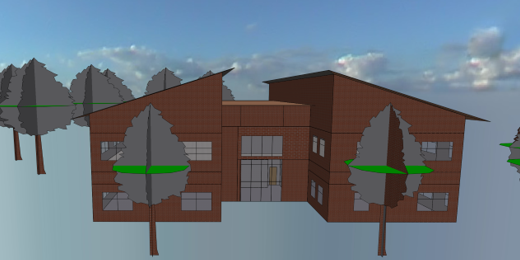This article is the first of a series dedicated to describe the activities performed to demonstrate iBECOME on Helix Building. The iBECOME vBMS will be deployed in the building and the before-after conditions will be quantified and compared.
Building Information
Helix building is located in Glasgow, Scotland and it is one of the case study buildings in the iBECOME project. The building is occupied by IES Ltd and DVN-GL,and was used as a pilot and test bed for various new software and features developed by IES in research projects throughout the years.
The building is a 2-floor office type building with a floor area of 2,900 m2 and it was constructed in 2002. It is mainly composed of open spaces, single offices, meeting rooms, kitchens and restrooms. It can allocate up to around 180 people.
Current Status of Building
The building is heated by radiators with manual radiator valves, supplied by a biomass boiler and controlled by two digital thermostats, once for each floor. The typical temperature setpoint is 23 ◦C, with a night setback of 15 ◦C for both of them.
The thermostat has two typical days programmed: working and weekend day. Additionally, a server room is equipped with a cooling unit (mini-split) that keeps the equipment at the correct operational temperature. Additionally, the building has 14 indoor environmental sensors and a weather station. The measurements include indoor temperature, relative humidity, CO2, motion and lighting levels (lux) and collected in iSCAN software every 15 minutes, which is used in iBECOME vBMS for modelling, storage and sharing with 3rd parties.
iBECOME Implementation
For the project, only the space occupied by IES is considered for the demonstration activities, this consist of 2,600 m2 of the building. It corresponds to the full ground floor and the right wing of the first floor.
For the demonstration activity it was agreed that the existing IoT infrastructure will be re-used as much as possible to reduce the costs of new hardware installations, since it was found that it can be integrated with the vBMS directly without the need of additional software or hardware.
In Autumn 2022, the iBECOME team installed some new equipment to enable the deployment of iBECOME vBMS on the site during the winter season. The radiator valves in meeting rooms were replaced with smart ones, to enable remote and automated control of the heating in these rooms.
Additionally, two new smart zone thermostats were purchased and integrated. The heat meters were repaired and integrated with iSCAN, as well as an electrical sub-metering squid was installed to measure electricity consumption. Finally, smart plugs were purchased and placed in sockets with high demand. All these devices were commissioned and tested that can be remotely accessed or controlled.
In parallel, the team updated the physics-based building energy model, that was developed in previous research projects, with the new equipment and informed the calibration. In simulations, the model can predict scenarios with very good accuracy and can be used to study energy efficiency scenarios, in quantification of energy savings as well as in heating control strategies during the building’s operation. During the winter and spring this year, the iBECOME team will be deploying and trialling all the services of the vBMS including:
- Energy-comfort optimisation in open office spaces and meeting rooms
- Fault Detection and Diagnosis on new equipment installed
- Predictive maintenance on the biomass boiler
- Demand response demonstration using smart plugs
- Measurement and Verification
- What-if retrofit scenarios
iBECOME Impact
After simulating the energy-comfort optimisation scenario, we found that there is potential in the building to introduce up to 10-15% heating energy savings while improving thermal comfort. Moreover, we target to improve illuminance, CO2 concentration and smart readiness indicator by 10%, as well as reduce the CO2 emissions and cut down energy bills by 15%, with a payback period of less than 3 years.
Stay tuned to find out more about the innovative services demonstration in Helix building.

